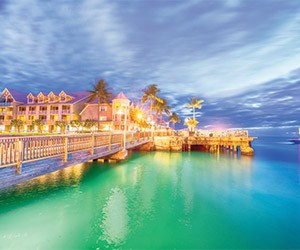One of the most welcoming, laid-back spots on the U.S. map, the Florida Keys are known for a thriving population of “Conchs”—friendly, colorful and just a bit cheeky.
But enough about the people. Wildlife in the Keys is just as distinctive and fascinating, whether under the sea, above the waves or soaring overhead. Surrounded by water and set just above the tropics, the Keys cut a watery path through Atlantic and Gulf of Mexico waters at the crossroads of North America and the Caribbean, and boast a diverse community of animal residents from both worlds—including threatened and endangered wildlife—who reside in habitats ranging from tropical hardwood hammocks and pine rocklands to mangrove forests and coral reefs.
Preserves, rescue centers and attractions in the Keys also provide a home for local wildlife, some offering close access to and interaction with their inhabitants. Following are several standout examples.
Dolphin Research Center, Grassy Key
Attendees will flip over the resident Atlantic bottlenose dolphins and California sea lions at the Dolphin Research Center, which specializes in presenting marine mammal education and research programs and is also the licensed manatee rescue team for the Florida Keys.
Narrated dolphin and sea lion behavior sessions and educational presentations are offered every half hour while interactive programs include dolphin swims, Trainer for a Day and Paint With a Dolphin, along with programs developed for individual groups.
“We have the ability to customize programs for whatever the needs of the group are,” says Susan Sorensen, director of guest services at the center. “Groups can get private educators and private tours, going as in-depth as they want.”
The center recently introduced Fantasy Dolphin Day for groups of up to 20, which offers private access to the center for the afternoon and evening and hands-on interaction with the dolphins. “It also includes dinner lagoon-side, a performance by the dolphins and photos taken of all the participants,” says Mary Stella, director of media and marketing at the center. PageBreak
Florida Keys Wild Bird Center, Upper Keys
It’s all for the birds at the Florida Keys Wild Bird Center, which rescues more than a thousand sick and injured native and migratory wild birds each year, monitoring a hundred-mile area from the Everglades to Marathon in the Middle Keys. While some birds are released back to the wild, others with permanent limitations remain at the center and are on display to visitors, including falcons, owls, hawks, turkey vultures, native songbirds and assorted shore birds.
These former patients, along with free-roaming birds, can be viewed from a boardwalk that snakes through five acres of wetlands leading to Florida Bay.
“Once at the bay, we have a free-flowing saltwater pond that brings in fish for the birds,” says Joan Scholz, the center’s executive director. “The birds eat and then go about their business. We have a picnic table so people can eat by the owls, and we have benches on the beach.”
Self-guided tours and group tours of 30-35 are available, while smaller groups may arrange a visit to the center’s new hospital, set just north of the center.
National Key Deer Refuge, Big Pine Key
They roam throughout the Lower Keys, but there’s a good chance groups will sight the elusive, endangered Key deer at the National Key Deer Refuge, a 9,200-acre preserve on Big Pine Key and No Name Key that encompasses upland forests, salt marshes and freshwater wetlands. The tiny deer—standing about 30 inches at the shoulders—were close to extinction by 1957 when the refuge was established, but numbers have since rebounded to about 800.
“Early morning and early evening are the best times to see the deer,” says Kristie Killam, park ranger at the refuge. “We encourage people to come down and experience this unique area.”
The refuge offers a visitor center, trails and wildlife observation areas, but guided tours are available with enough advance notice.PageBreak
Crane Point Museum and Nature Center, Marathon
Nature trails wind through a 63-acre hardwood hammock at Crane Point, where visitors may spot white-crowned pigeons, osprey, hawks and a variety of native birds that swoop in and out during the day. On-site are a butterfly garden and changing exhibits featuring hermit crabs, lizards, snakes and insects. Also on-property is the Marathon Wild Bird Center, which has rescued, rehabilitated and released close to 6,000 injured wild birds since its founding in 1998.
Combining Crane Point’s various attractions can make for a memorable group experience.
“We just had a group from Belgium here, and I set up a walking tour with a guide through the hammock and through Adderley House, the oldest house outside Key West,” says Loretta Geotis, director of operations at the center. “They had a presentation at the Bird Center, then the Florida Keys National Marine Sanctuary came in and did a presentation. [The group] spent two or three hours here and got a broad overview of the environment.”
Those with a tighter schedule might opt for a walking tour followed by a powwow in the center’s picturesque courtyard, but tailored programs are available whether you come for an hour or a day.
“Our mission here at Crane Point is to promote the environmental stewardship of the Florida Keys,” Geotis says. “If we don’t do it, it’s going to go away.”
The Turtle Hospital, Marathon
A hospital is something most travelers try to avoid, unless it’s Turtle Hospital, a popular attraction that also touts itself as the world’s only licensed veterinary hospital dedicated to the treatment of sea turtles.
“We typically average 70 new turtles each year,” says Teresa Ryan, one of the educators at the hospital. “The goal is to release them back to the sea.”
Among the hospital’s more famous patients was a 215-pound loggerhead sea turtle named after President Obama. “Obama” was rescued on Key West’s Higgs Beach Jan. 19, 2009, a day before the 44th president of the U.S. was sworn in. The loggerhead made a full recovery and was returned to sea.
The facility offers daily tours on the hour, taking guests through the hospital area and on to the turtle enclosure, home to recovering turtles and those too injured to go back into the wild. Private group tours are available.PageBreak
Key West Butterfly & Nature Conservatory
Get those phone cameras ready. The Key West Butterfly & Nature Conservatory features between 1,000 and 1,500 of the delicate winged creatures in a climate-controlled greenhouse, but they’re not alone.
“We also have 35 species of birds, Japanese koi in our ponds, turtles and frogs,” says Kyle Caskey, group tour manager at the conservatory.
In addition to personalized group outings, the conservatory offers twilight tours that include wine, champagne or nonalcoholic beverages.
“I’ve had people bring in hors d’oeuvres for a reception in the gallery area,” Caskey says.
John Pennekamp Coral Reef State Park, Key Largo
Schools of fish and dazzling coral reefs (which are composed of living animals, by the way) are as close as a glass-bottom boat tour at Pennekamp Park. Get even closer with snorkel and dive trips that bring you face-to-face with parrotfish, barracuda, sea urchins, Caribbean spiny lobster, giant sea anemone and endless other marine life. All are offered through the park’s concessionaire, Coral Reef Park Company, and groups may join other divers and boaters, or planners can arrange private excursions.
“We have four 49-passenger snorkel boats and a 130-passenger glass-bottom boat,” says Daryl Obenour., Coral Reef’s general manager. “Trips are two-and-a-half hours, but we can arrange longer excursions as well.”






